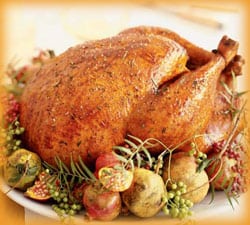
OSFM discourages use of turkey fryers due to increased fire danger

SPRINGFIELD – To ensure a cheerful holiday season, the Illinois Office of the State Fire Marshal (OSFM) is encouraging consumers to be extra careful when cooking holiday meals and decorating their homes.
“Cooking fires are more likely to occur on Thanksgiving than on any other day of the year,” said Dave DeFraties, Acting State Fire Marshal. “The incidence of home cooking fires is roughly three times the daily average on Thanksgiving.”
Turkey Fryer Dangers
The dangers of home cooking fires are greatly increased due to the relatively recent popularity of turkey deep frying appliances. OSFM joins the National Fire Protection Association (NFPA) and the American Burn Association (ABA) in discouraging the use of turkey fryers to prepare holiday meals because of the risk of injuries and fires associated with these unique devices.
Tests have shown that many of the fryers have a risk of tipping over, overheating, or spilling hot oil, leading to fires and burns. This deep-frying cooking process requires that up to five gallons of oil be heated to high temperatures before lowering the turkey into the device.
If you prefer fried turkey during the holidays, the safest options are to order a pre-cooked bird from a local supermarket or restaurant, or hire a professional caterer.
Holiday Decoration Safety
Christmas trees are among the most popular decorations of yuletide, but they also can be deadly. On average each year, live and artificial Christmas trees are the ignition sources of 300 reported U.S. home fires each year resulting in 14 fatalities, 21 injuries and $16.8 million in property damage, according to NFPA.
In addition, 44 percent of Christmas tree fires are caused by an electrical problem or malfunction. To be safe with trees and decorations, OSFM urges consumers to:
Regularly check your tree for fresh, green needles. Trees that have dried out over several weeks’ time burn faster than those that are fresh and well-watered. Remember to keep your tree watered at all times.
Make sure your tree stand holds at least 1 gallon of water. As a general rule, stands should provide 1 quart of water per inch of trunk diameter. The average 6-foot tree has a 4-inch diameter trunk and can consume as much as 4 quarts or 1 gallon of water per day.
Keep your tree at least 3 feet from fireplaces, radiators, space heaters, heating vents and other sources of heat. Don’t place the tree where it blocks an exit.
Look for the Underwriters Laboratory (UL) mark on light strings, electrical decorations and extension cords. The UL mark means that UL engineers have tested representative samples of the product for foreseeable safety hazards such as fire and electric shock.
Ensure outside lights, decorations and extension cords are rated for outside use. Lights intended for indoor-only use bear green holographic UL marks. Light strings intended for indoor and outdoor use bear red holographic UL marks.
Carefully inspect each electrical decoration—new or old—before plugging it in. Cracked sockets, frayed, bare or loose wires can cause a serious electric shock or start a fire. Replace damaged items with new, UL-listed decorations.
Don’t use staples or nails to hang light strings. Instead, purchase plastic hooks or clips designed for hanging light strings.
Check packaging to determine the maximum number of strings that may be connected or use this rule of thumb: Connect a maximum of three midget (push-in bulbs) light strings or up to 50 bulbs of light strings with the screw-in bulbs (C7s and C9s).
Don’t overload extension cords by plugging in too many decorations.
Turn off all electrical lights and decorations before leaving home or going to bed.
Read and follow the manufacturer’s instructions for electrical decorations.
For more information, please visit the agency’s Web site at www.state.il.us/osfm or NFPA at http://www.nfpa.org/.
